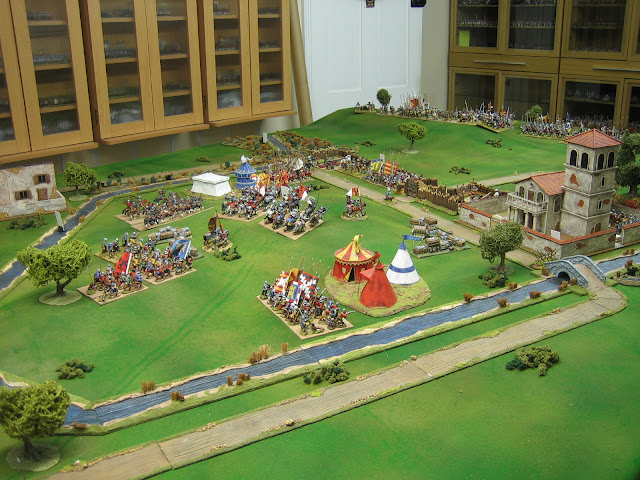 The above shot shows the Battle of Fastapasta at the end of turn one. I used the embryonic "Thirst of War and Blood" to fight the battle. Over the last couple of weeks these rules, in their tabular form, have received much attention and 'on paper play-testing'. They are still not right, but they are certainly getting there.
The above shot shows the Battle of Fastapasta at the end of turn one. I used the embryonic "Thirst of War and Blood" to fight the battle. Over the last couple of weeks these rules, in their tabular form, have received much attention and 'on paper play-testing'. They are still not right, but they are certainly getting there. 
In the very first initiative the French turn a march card. On the far side of the field the French command, including the Swiss pike, rolls more and triple - three moves! The Swiss have a D12 combat die and, moving their combat die in inches, advance 36" in a single bound. This is a game of decision; as in real war, once the enemy starts to move it is often too late to transmit orders to intervene - which is often far too easy in most war games, where things are signposted by movement rates that are far too short.
What is more, they have rolled even so can initiate a melee versus the Landsknecht pike square. They win the first round. The Landsknechts only save themselves from rout by expending a morale chip to invoke stubborn status - they have lost less unit integrity (UI) than the total number of rear rank stands - to convert a rout into a push back.
Almost immediately the French turn a melee card, on a won 'lull card' roll where the initiative can be stolen, and must resolve the ongoing melee. This time the advance of the Swiss is slowed - a hard fought melee, the Swiss still have the advantage but the sheer weight of the Landsknecht pike square is beginning to tell.
The Swiss storm the earthworks (below) rolling over the artillery and into contact with the Landsknechts. This will prove to be important later....

The French turn an officer check card and rally back their losses. (I've used some nice contemporary portraits on the leadership quality markers - this one is Alfonso of Ferrara).
In the next round of melee a draw is obtained - more UI losses but no advantage to either side.
Then the Imperialists turn "Four horsemen"; a characterisation card. It gives four extra impetus points to turn cards! It enables the Imperials to position themselves against the French attack which looks like it is about to become general.

The battle between the Swiss and Landsknechts continues on every melee card that is turned. The fight turns dramatically in the Landsknechts favour, but they are unable to take full advantage because they are pinned by the other Swiss pike square.
On the other side of the field the advance of the French Landsknechts and Picard pike is slowed dramatically by well timed artillery fire. Both squares are vexed and move at half speed.

Then the turn ends on an equal roll, in this case double ones.
Below are some shots of the field at 'turn end'. They show that much more went on in the turn (of 17 impetus each) than is pictured in detail above.
The Fight between Landsknechts and Swiss.
The Imperialists rush their Papal allies to guard the rear of the camp.
The Imperial camp under attack.
Here they come!
I'm fighting this one solo. I aim to get in several more turns over the next few days. I'll try and do a similar report for all.












































